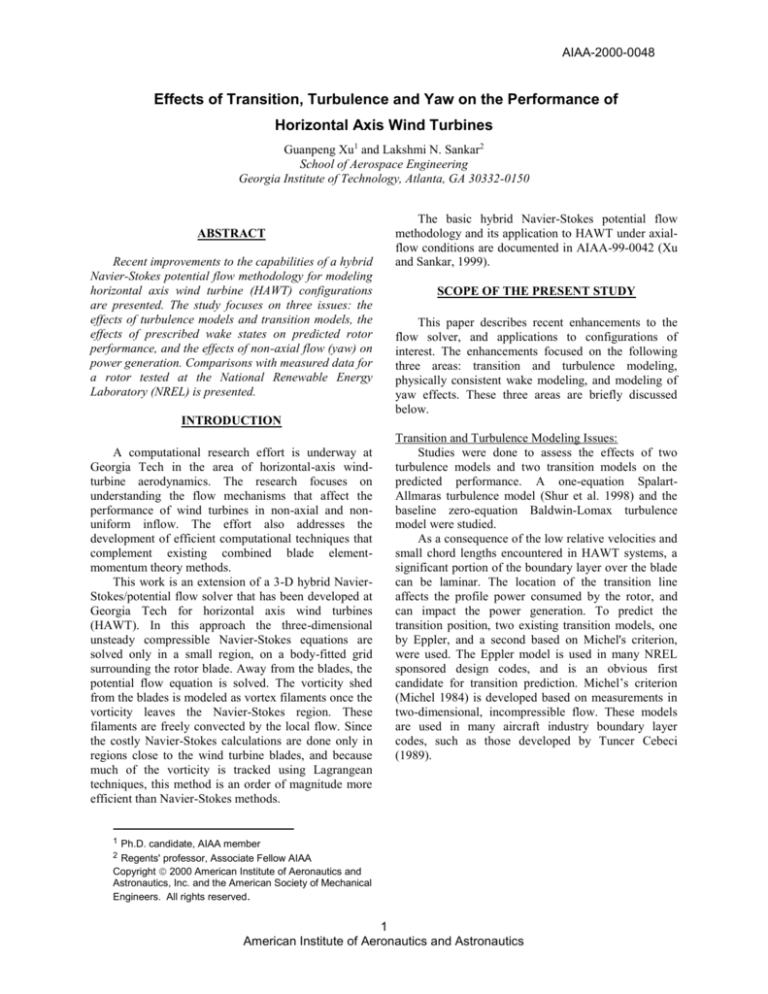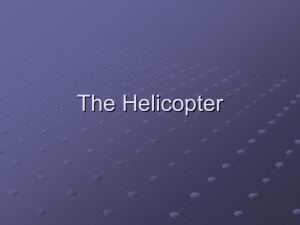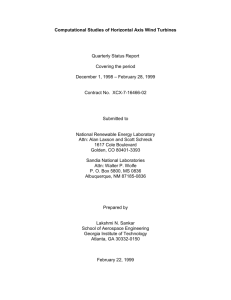
AIAA-2000-0048
Effects of Transition, Turbulence and Yaw on the Performance of
Horizontal Axis Wind Turbines
Guanpeng Xu1 and Lakshmi N. Sankar2
School of Aerospace Engineering
Georgia Institute of Technology, Atlanta, GA 30332-0150
ABSTRACT
Recent improvements to the capabilities of a hybrid
Navier-Stokes potential flow methodology for modeling
horizontal axis wind turbine (HAWT) configurations
are presented. The study focuses on three issues: the
effects of turbulence models and transition models, the
effects of prescribed wake states on predicted rotor
performance, and the effects of non-axial flow (yaw) on
power generation. Comparisons with measured data for
a rotor tested at the National Renewable Energy
Laboratory (NREL) is presented.
The basic hybrid Navier-Stokes potential flow
methodology and its application to HAWT under axialflow conditions are documented in AIAA-99-0042 (Xu
and Sankar, 1999).
SCOPE OF THE PRESENT STUDY
This paper describes recent enhancements to the
flow solver, and applications to configurations of
interest. The enhancements focused on the following
three areas: transition and turbulence modeling,
physically consistent wake modeling, and modeling of
yaw effects. These three areas are briefly discussed
below.
INTRODUCTION
A computational research effort is underway at
Georgia Tech in the area of horizontal-axis windturbine aerodynamics. The research focuses on
understanding the flow mechanisms that affect the
performance of wind turbines in non-axial and nonuniform inflow. The effort also addresses the
development of efficient computational techniques that
complement existing combined blade elementmomentum theory methods.
This work is an extension of a 3-D hybrid NavierStokes/potential flow solver that has been developed at
Georgia Tech for horizontal axis wind turbines
(HAWT). In this approach the three-dimensional
unsteady compressible Navier-Stokes equations are
solved only in a small region, on a body-fitted grid
surrounding the rotor blade. Away from the blades, the
potential flow equation is solved. The vorticity shed
from the blades is modeled as vortex filaments once the
vorticity leaves the Navier-Stokes region. These
filaments are freely convected by the local flow. Since
the costly Navier-Stokes calculations are done only in
regions close to the wind turbine blades, and because
much of the vorticity is tracked using Lagrangean
techniques, this method is an order of magnitude more
efficient than Navier-Stokes methods.
Transition and Turbulence Modeling Issues:
Studies were done to assess the effects of two
turbulence models and two transition models on the
predicted performance. A one-equation SpalartAllmaras turbulence model (Shur et al. 1998) and the
baseline zero-equation Baldwin-Lomax turbulence
model were studied.
As a consequence of the low relative velocities and
small chord lengths encountered in HAWT systems, a
significant portion of the boundary layer over the blade
can be laminar. The location of the transition line
affects the profile power consumed by the rotor, and
can impact the power generation. To predict the
transition position, two existing transition models, one
by Eppler, and a second based on Michel's criterion,
were used. The Eppler model is used in many NREL
sponsored design codes, and is an obvious first
candidate for transition prediction. Michel’s criterion
(Michel 1984) is developed based on measurements in
two-dimensional, incompressible flow. These models
are used in many aircraft industry boundary layer
codes, such as those developed by Tuncer Cebeci
(1989).
1
Ph.D. candidate, AIAA member
Regents' professor, Associate Fellow AIAA
Copyright 2000 American Institute of Aeronautics and
Astronautics, Inc. and the American Society of Mechanical
Engineers. All rights reserved.
2
1
American Institute of Aeronautics and Astronautics
AIAA-2000-0048
Wake Geometry Modeling:
The prescribed wake model in the hybrid NavierStokes/Potential flow analysis has been modified to
properly reflect the states that a rotor can assume, as the
wind speed changes. It is based on the theory and
phenomenology of rotor states, which was presented by
Glauert (1937) and was extended by Wilson and
Lissaman (1972) to wind rotors.
D
1
~
2
cb1 1 f t 2 S ~ ~ ~ cb 2 ~
Dt
2
cb1 ~
cw1 f w 2 f t 2 f t1U 2
d
Here S is the magnitude of the vorticity, and
Yaw Effects:
Finally, a numerical procedure for modeling
skewed wind (yaw) conditions has been developed. As
in axial flow simulations, the yaw calculations only
need to model the aerodynamics of a single blade.
Other blades will experience the same load and flow
pattern 1/N revolutions later, where N is the number of
blades. For a three-bladed rotor the computational
domain covers a 120 portion of the rotor disk. The
present procedure thus retains the efficiency of hybrid
method even for yaw conditions. In contrast to the
hybrid method, a full Navier-Stokes solver would
require the modeling of all blades, significantly
increasing the computational effort.
Also, d is the distance to the closest wall, and,
~
~
S S
fv2 1
The function
ui u j 2 t S i j
(1)
Where
S i j U i x j U j xi 2
The eddy viscosity
t is given by
t ~
f v1
(3)
Where,
3
f v1 3
cv31
And,
(2)
~
Here is the molecular viscosity. The quantity ~ is
the working variable and obeys the transport equation.
(6)
f w is given by the following
1
6
(7)
g r cw 2 r 6 r
(8)
~
r ~ 2 2
S d
(9)
For large values of r, fw asymptotically reaches a
constant value; therefore, large values of r can be
truncated to 10 or so.
The Wall boundary condition is ~
= 0. In the
~
freestream = 0 is found to work best, provided
numerical errors do not push ~
to negative values near
the edge of the boundary layer. Values below 10
are acceptable.
The Spalart-Allmaras model has a built-in
provision for driving the eddy viscosity to zero
upstream of the transition point. This is done by the ft2
function, which goes to unity upstream of the transition
point.
f t 2 ct 3 exp ct 4 2
The trip function
Where
(5)
1 f v1
1 c6
f w g 6 w63
g cw3
And
Spalart-Allmaras Turbulence Model:
The first enhancement to the hybrid analysis was
the replacement of a simple algebraic eddy viscosity
model with a phenomenological one-equation eddy
viscosity model called the Spalart-Allmaras model.
In this model, the Reynolds stresses are given by
~
f v2
2 2
d
(4)
expression:
MATHEMATICAL AND NUMERICAL
FORMULATION
A complete description of the hybrid theory behind
the present hybrid approach is given in AIAA-99-0042
(Xu and Sankar, 1999). Sankar and his coworkers have
also used the hybrid procedure in several fixed and
rotary wing solvers.
For this reason, only the
turbulence and transition model enhancements, and the
extension of the flow solver to yaw conditions are
presented here.
(10)
f t1 is computed as follows. Let dt
be the distance from the field point to the trip location,
which is on a wall. Let the quantity t be the wall
vorticity at the trip location, and U the difference
between the velocity at the field point and that at the
trip. Then one can compute an intermediate
quantity g t min 0.1, U t x where x is the
grid spacing along the wall at the trip location. Finally,
2
(11)
f t1 ct1 g t exp ct 2 t 2 d 2 g t2 d t2
U
2
American Institute of Aeronautics and Astronautics
AIAA-2000-0048
The constants are:
cb1=0.1355, =2/3, cb2= 0.622, =0.41,
3
3 u
G 2 2e R x1tr.34
C
c1 cb1 1 cb 2 , c2 =0.3, c 3 =2,
2
The transition Reynolds number is defined as:
c1 =7.1, ct1 1, ct 2 2 ct 3 1.1 , ct 4 2 .
R x tr
Further details on the Spalart-Allmaras model are
given by Shur et al. (1998).
Eppler Transition Prediction Model
The second enhancement to the hybrid method was
the incorporation of transition line prediction models.
Two models, one by Eppler, and the second by Michel
have been investigated.
The Eppler’s transition model was implemented in
the hybrid Navier-Stokes/Potential flow analysis, in the
following manner. Every 10 time steps or so, the
surface pressure distribution on the turbine blade is
passed to an integral boundary layer analysis, one radial
location at a time. Inside the boundary layer analysis,
the streamwise growth of laminar boundary layer
quantities such as the momentum thickness , shape
factor H, energy thickness 3, and the factor H32=3/
are computed using Thwaites' method (Thwaites,
1949). Transition is predicted to occur if the Reynolds
number based on the momentum thickness becomes
large so that:
u
log e 18.4 H 32 21.74 0.34r (12)
Here u e is the velocity at the edge of boundary layer,
and ‘r’ is a roughness factor. For highly polished
surfaces, r may be taken to be zero.
This model also predicts that transition has
occurred if the laminar boundary layer separates, and
forms a separation bubble near the leading edge of the
rotor.
Chen-Thyson Transition Model and Michel’s Criterion:
In this model, transition is said to occur at the
chordwise location where the local Reynolds number
based on the momentum thickness R is related to the
Reynolds number based on length R x by,
22400 0.46
R x
R 1.1741
R x
(13)
In order to avoid an abrupt transition, Chen and
Thyson recommend that the eddy viscosity be
multiplied by the factor:
x dx
tr 1 exp Gx x tr
x tr u
e
Upstream of onset point of transition region,
set to zero. The quantity G is computed from:
(14)
tr is
(15)
And,
uex
tr
(16)
C2 213 log R x tr 4.7323
(17)
It should be noted that the quantity Rx is based on
the local freestream velocity (the magnitude of the
vector sum of wind speed, induced velocity, and the
blade velocity due to rotation r ). Thus, for wind
turbines,
x u local
u local x c Vtip
x
Rx
cVtip u~local Re tip (18)
c
The non-dimensional velocity
u~local is computed
as,
v
vi
u~local wind
V
tip
2
2
r
R
(19)
Where r is the local radial distance from the hub, R is
the tip radius, and x c is non-dimensional x
coordinate. Induced velocity vi is estimated to a first
order from the momentum theory. The Reynolds
number based on the momentum thickness is also
computed using the free-stream velocity, not the
boundary layer edge velocity.
Methodology for Yaw Simulation
A numerical procedure for modeling off axis wind
(yaw) conditions has been developed. As in axial flow
calculations, the yaw calculations only need to model
the aerodynamics of a single blade. Other blades will
experience the same load and flow pattern 1/N
revolutions later, where N is the number of blades. For
a three-bladed rotor the computational domain covers a
120 portion of the rotor disk at a specific running time.
The present procedure thus retains the efficiency of the
hybrid method even for yaw conditions. In contrast to
the hybrid method, a full Navier-Stokes solver would
require the modeling of all blades, greatly increasing
the computational effort.
When developing the first-principles based analysis
for modeling rotors in cross flow, there are three kinds
of non-axial flow (yaw) effects that should be
addressed. First is the difference in the flow between
the advancing and retreating sides due to the “edgewise” velocity component in the plane of rotor disk. As
shown in figure 1, the turbine blade experiences a
higher relative velocity on the advancing side than on
3
American Institute of Aeronautics and Astronautics
AIAA-2000-0048
the retreating side. This fluctuation in velocity produces
fluctuations in the blade loads, and the power
generated.
The second effect that must be modeled is the
skewness of tip vortex wake as shown in figure 2. This
results in an azimuthally non-uniform induced flow
field at the rotor plane. Furthermore, the vorticity
strength in the wake will vary with time, as the loads on
the blade vary with time. This is in contrast to axial
flow, where the blade loading is independent of the
azimuthal location of the blade.
Finally, the analysis must include aeroelastic
deformation of the rotor blades, and blade teetoring and
flapping motion, if any. Since the rotor tested by NREL
uses stiff blades, the blade was assumed to be rigid
without any cyclic pitching or flapping of the blades.
The present Hybrid methodology has been
extended to simulation of yaw conditions. This method
uses a skewed wake geometry to model yawed flow
conditions. The skew angle is determined by the ratio
between the inflow velocity (which is a combination of
the induced velocity from momentum theory and the
normal component of wind velocity), and the edgewise
component of wind velocity.
A two step precedure has been used for modeling
yaw effects. The first step simulates axial flow
conditions at a given wind speed. When the hybrid
code has converged, the tip vortex strength, and the
wake geometry for the axial flow condition are saved.
These quantities serve as the initioal condition for the
second step, where the wake geometry is skewed as
discussed above, and the edgewise velocity component
is applied to the “freestream” velocity.
At every 10 degree increments in azimuth, the peak
bound circulation strength at that azimuthal angle is set
to be the strength for all the tip vortex segments that
were shed from all the blades when they were at that
azimuthal angle. After two revolutions of the refrence
blade, the flow field may be considered to be welldeveloped and periodic.
Unlike the axial flow condition, the flow properties
of the reference blade will not converge to a steady
state solution in yaw. Repeatability of the blade loads
from one revolution to the next is used as the criterion
for convergence.
RESULTS AND DISCUSSION
Transition Model and Turbulence Model Studies:
The Eppler and Michel transition models, along
with the Baldwin-Lomax and the Spalart-Allmaras
turbulence models have been fully integrated into the
Georgia Tech hybrid code. Figure 3 and Figure 4 show
the prediction transition lines on the upper surface and
lower surface for a wind turbine known as NREL Phase
III rotor (Schepers 1997), operating at a wind speed of
6 m/s. The rotor operates at 72 rpm. At this low wind
speed condition, the flow field behaves nicely, with
attached flow over most of the rotor. In these figures,
the legends '0 eqn' and '1 eqn' represent the BaldwinLomax and the Spalart-Allmaras models, respectively.
On both the upper and the lower surface, Eppler’s
model predicts a transition location that is upstream of
Michel’s predictions. Eppler’s model, as implemented
in the present code, first checks to see if laminar
boundary layer has separated. If so, Eppler’s model
assumes that transition has occurred. Note that the
inflexion point on the separated flow boundary layer
will cause Tollmien-Schlichting instability to develop,
causing transition. The Michel criterion, on the other
hand, bases its transition criterion primarily on the
boundary layer thickness. At this wind speed, the
boundary layer has to grow up to 55% chord or so,
before Michel’s criterion detects transition.
On the lower surface, the pressure gradients tend to
be more favorable than on the upper side. This leads to
a thinner boundary layer and separation aft of the 40%
chord. As a consequence, both these criteria predict that
transition will occur aft of the corresponding upper
surface locations.
The Reynolds number near the root is less than 10 5.
Both models predict that the flow will remain laminar
all the way to the trailing edge near the root region. It is
also observed that the transition line location is
relatively insensitive to the turbulence model used.
Figure 5 shows the transition lines on the lower
surface of the CER Phase III rotor at 8m/s. Even
though the overall pattern of the transition lines is
similar to the 6m/s case, the following differences may
be observed:
a) Michel’s model predicts that the transition
phenomenon over much of the lower surface is
delayed, compared to the 6m/s case. This is
attributable to the higher local angle of attack the
blade sections operate in, and the favorable
pressure gradients that exist on the windward side
of the rotor.
b) The Eppler transition model, on the other hand,
predicts transition lines that are similar at the 8m/s
and 6m/s conditions, presumably because laminar
separation is detected in the vicinity of 40% chord
at both these wind conditions. Notice that the
maximum thickness location for the S-809 airfoil
is near 40% chord. The pressure gradient tends to
be favorable from the leading edge up to 40%
chord, after which it becomes adverse at both these
wind conditions.
c) At the higher wind speed, a larger region near the
root on the windward side remains laminar.
d) The transition line predicted using the Michel’s
transition model in conjunction the SpalartAllmaras turbulence model has a kink near the
4
American Institute of Aeronautics and Astronautics
AIAA-2000-0048
33% radius. The reason for this behavior is not
known at this writing.
Figure 6 shows the transition lines on the upper
surface at 8m/s. Eppler’s model predicts that transition
will occur near the leading edge, as a result of leading
edge separation. Michel’s model, on the other hand,
predicts transition around 50% chord, with a
considerable radial variation in the transition location,
especially near the root.
The large difference observed in the upper surface
transition pattern of the rotor between the 8 m/s and the
6 m/s is attributable to the changes in the operating state
of the turbine. For the Phase III rotor at 72 rpm, as the
wind speed increase to around 8m/s, the operating state
switches from a wind turbine state to a turbulent wake
state (Wilson, R. E. et al., 1974).
to turbulent flow is now modeled using empirical
transition models. Phenomenological one-equation
turbulence models have replaced algebraic turbulence
models. The code has been modified to model yaw
effects. Preliminary calculations done to validate these
enhancements show that the predictions are consistent
with measurements.
Yaw Results
The hybrid code has been modified to account for
three yaw effects as described earlier. The Phase III
rotor was studied for a 10 m/s wind, and a 20-degree
fixed yaw condition. Figure 7 shows the total power
generated by all the three blades, taking into account
the phase difference among the blades. The
instantaneous power curve shows high frequency
components superposed on a mean value. The power
fluctuations are about 4% of the time-averaged power.
The time-averaged values are in good agreement with
NREL data.
Figure 7 is the result after Fourier filtering of the
present results because the data from the simulation
contain numerical noise. For example, in the present
simulations, the wake induced velocity is updated once
every 10 degrees of azimuth. This produces numerical
noise at a wave number of 36, that must be filtered out.
Measurements for the Phase IV rotor of NREL
were comparied with results of Hybrid solver. The
Phase IV rotor of NREL has the same geometry as the
Phase III rotor, but has improved measurement devices.
A time series of unsteady measurement lasts 16
seconds, or 18 revolutions of the rotor. The measured
data not only includes the effects of yaw and unsteady
wind inflow, but also other effects such as the tower
shadow and wind shear. Figure 8 shows the
unsteadiness of the measured wind.
Figure 9 compares the present hybrid method
results with the measured data at five typical time
intervals, each interval correspionding to one blade
revolution. Both the computed data and the
measurements show comparable fluctuations in the
power, about comparable mean value.
Tuncer Cebeci, "Essential Ingredients of a Method for
Low Reynolds-Number Airfoils," AIAA Journal Vol.
27, No. 12, December 1989, pp. 1680-1685.
CONCLUDING REMARKS
Spalart, P. R., and Allmaras, S. R., "A One-Equation
Turbulence Model for Aerodynamic Flows," AIAA-920439.
The Georgia Tech wind turbine code has been
extensively modified. The transition from laminar flow
ACKNOWLEDGEMENTS
The National Renewable Energy Laboratory
(NREL) supported this work. Alan Laxson and Scott
Schreck of NREL, and Walter Wolfe of Sandia
National Laboratory are the technical monitors.
REFERENCES
Chen, K. K., and Thyson, N. A., "Extension of
Emmons' Spot Theory to Flow on Blunt Bodies," AIAA
Journal, Vol. 9, 1971, pp. 821-825
Eggleston and Stoddard, Wind Turbine Engineering
Design, ISBN 0-442-22195-9
Eppler, R., Airfoil Design and Data, New York, NY,
Springer-Verlag, 1990, 562 pp.
Glauert, H. "Airplane Propellers," From Div. L,
Aerodynamic Theory, ed. W. F. Durand, Berlin:
Springer Verlag, 1935.
R. Michel, et al, "Stability Calculations and Transition
Criteria on Two- or Three-Dimensional Flows,"
Laminar-Turbulent Transition, Novosibirsk, USSR,
July 9-13, 1984, pp. 455-461.
Thwaites, B., “Approximate calculation of the laminar
Boundary layer,” Aeronautical Quarterly, Vol. 1, 1949,
pp.245-280.
Schepers, et al "Final Report of IEA ANNEX XIV:
Field Rotor Aerodynamics". Netherlands Energy
Research Foundation, ECN-C-97-027
M. Shur, et al, "Turbulence Modeling in Rotating and
Curved Channels: Assessment of the Spalart-Shur
Correction Term," AIAA 98-0325.
5
American Institute of Aeronautics and Astronautics
AIAA-2000-0048
Wilson, R. E. and Lissaman, P. B. S., "Applied
Aerodynamics of Wind Power Machines," Oregon State
University, 1974.
Xu, G., and Sankar, L. N., "Computational Study of
Horizontal Axis Wind Turbines," AIAA Paper 99-0042.
Advancing Side
0 eqn; Eppler
Leading Edge
1 eqn; Eppler
R
Vx
0 eqn; Michel
1 eqn; Michel
Root
Tip
Fig. 4 Transition lines on lower surface
of Phase III rotor in 6 m/s
Retreating Side
-3
Figure 1: Realtive Velocities in the Disk Plane
1 eqn; Eppler
-2
v I (r,)
0 eqn; Eppler
-1
Leading Edge R
0
0 eqn; Michel
1
1eqn; Michel
Root
Tip
2
Fig. 5 Transition lines on lower surface of
Phase III
4
6 rotor in 88m/s
10
3
0
2
12
-3
Figure 2. Schematic of the Skewed wake
-2
-3
1 eqn; Eppler
-1
0 eqn; Eppler
-1
0 eqn; Eppler
-2
Leading Edge
0
Root
2
0 eqn; Michel
1eqn; Michel
0 eqn; Michel
Root
2
2
1eqn; Michel
Tip
Tip
0
0
R
R
3
3
Leading Edge
0
1
1
1 eqn; Eppler
Fig. 34Transition lines
on upper
surface of10
6
8
Phase III rotor in 6 m/s
2
Fig. 6 Transition lines on upper surface
4
6
10
of Phase III
rotor in 88m/s
12
6
American Institute of Aeronautics and Astronautics
12
AIAA-2000-0048
Inflow Wind in One Time Series for 18 Revolutions
Power by Hybrid Code for 10m/s and 20 deg Yaw
11.5
7.6
11.0
7.6
7.5
7.4
7.4
Wave Number 9 and less
Wave Number 15 and less
Mean
7.3
7.3
0
50
100
150
200
Azimuthal Angle
250
300
350
Inflow wind(3)
inflow wind(4)
10.5
10.0
9.5
9.0
8.5
8.0
0
Fig. 7 Hybrid Code Predicted
Instantaneous Power Generation for the
Phase III rotor at 20 degree yaw
2
4
6
8
10
Time(sec)
9.5
9.0
8.5
8.0
7.5
7.0
6.5
Present Calculations 10m/s wind
Average Wind Speed 8.83m/s
Average Wind Speed 10.8m/s
Average Wind Speed 10.1m/s
Average Wind Speed 8.92m/s
Average Wind Speed 10.2m/s
6.0
5.5
5.0
0
45
90
135
12
Fig 8. Natural Inflow Wind in an
Experimental Time Series for 18
Revolutions
Phase IV Measured Power Vs. Time at 20 degree Yaw
(NREL data for a typical wind condition)
10.0
Power
Power (KW)
Mean
7.5
Measured Wind Speed
7.7
180
t
225
270
315
360
Fig 9 Correlation of Hybrid Yaw Results with Unsteady Measurement
7
American Institute of Aeronautics and Astronautics
14
16








